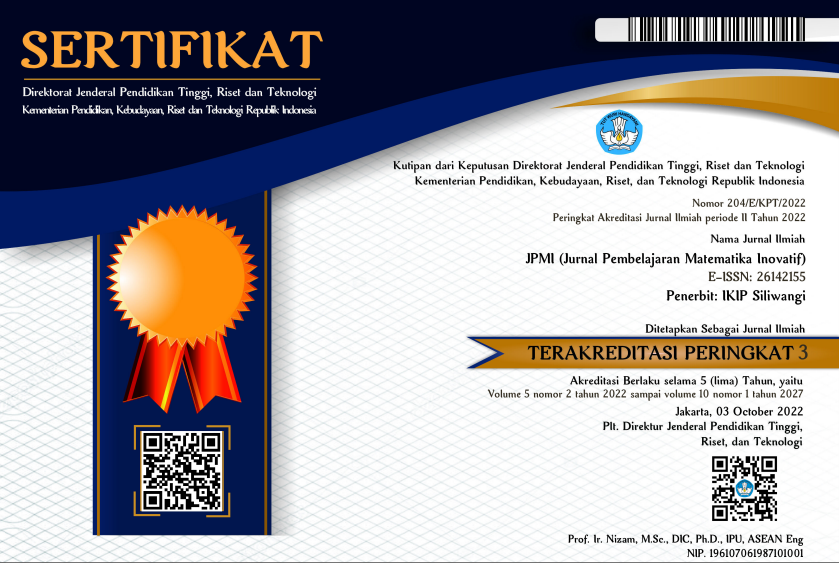Pengembangan lembar kerja peserta didik menggunakan model problem based learning berbantuan liveworksheets pada materi aritmatika sosial
DOI:
https://doi.org/10.22460/jpmi.v6i6.19438Keywords:
Problem based learning, LKPD, Social ArithmeticsAbstract
This study intends to determine the feasibility and practicality of worksheets for students of Social Arithmetic material using the Liveworksheets-assisted Problem Based Learning learning model. The development model used is the 4D method which is limited to the third step which includes: define, design and develompment stages. Feasibility test data and practicality of LKPD were collected through observation and questionnaires. The feasibility of LKPD is analyzed based on the results of validation by experts and the practicality of LKPD seen from student questionnaire responses. The subjects of this study were50 students on a small scale and 30 students on a broad scale .The results of this study show that the LKPD tested is very feasible and very practical to use for learning. This is seen based on the results of validation by experts who get an average of 95% with very valid categories and the practicality of LKPD taken from student response questionnaires with a percentage of 8,567% on a small scale and 88,33% on a broad scale. This shows that LKPD uses the Liveworksheets-assisted Problem Based Learning learning model on Social Arithmetic material is very valid and practical to use.
References
Agustina, R., Irhasyuarna, Y., & Sauqina. (2022). Pengembangan media articulate storyline topik mekanisme pendengaran manusia dan hewan untuk peserta didik SMP. JUPEIS : Jurnal Pendidikan Dan Ilmu Sosia, 1(3), 81–89. https://doi.org/https://doi.org/10.55784/jupeis.Vol1.Iss3.119
Alfansyur, A., & Mariyani, M. (2019). Pemanfaatan media berbasis ICT ‘Kahoot’dalam pembelajaran PPKN untuk meningkatkan motivasi belajar siswa. Bhineka Tunggal Ika. Bhineka Tunggal Ika, 6(2), 208–216. http://repository.radenintan.ac.id/4286/1/SKRIPSI CAHYA KURNIA.pdf
Elfina, S., & Sylvia, I. (2020). Pengembangan lembar kerja peserta didik (LKPD) berbasis problem based learning (PBL) dalam meningkatkan kemampuan berpikir kritis siswa pada mata pelajaran sosiologi di SMA Negeri 1 Payakumbuh. Jurnal Sikola: Jurnal Kajian Pendidikan Dan Pembelajaran, 2(1), 27–34. https://doi.org/https://doi.org/10.24036/sikola.v2i1.56
Fitriani, N., Hidayah, I. S., & Nurfauziah, P. (2021). Live worksheet realistic mathematics education berbantuan geogebra: meningkatkan abstraksi matematis siswa SMP pada materi segiempat. JNPM (Jurnal Nasional Pendidikan Matematika), 5(1), 37. https://doi.org/10.33603/jnpm.v5i1.4526
Friantini, R. N., Winata, R., & Permata, J. I. (2020). Pengembangan modul kontekstual aritmatika sosial kelas 7 SMP. Jurnal Cendekia : Jurnal Pendidikan Matematika, 4(2), 562–576. https://doi.org/10.31004/cendekia.v4i2.278
Haryonik, Y., & Bhakti, Y. B. (2018). Pengembangan bahan ajar lembar kerja siswa dengan pendekatan matematika realistik. MaPan, 6(1), 40–55. https://doi.org/10.24252/mapan.2018v6n1a5
Hasanah, U. (2022). Implementasi model pembelajaran kooperatif contextual teaching and learning untuk meninggkatkan hasil belajar matematika pokok bahasan aritmatika sosial bagi siswa SMP Negeri 1 Pemenang. Jurnal Paedagogy, 9(1), 159. https://doi.org/10.33394/jp.v9i1.4536
Hidayat, A., & Irawan. (2017). Pengembangan LKS berbasis RME dengan pendekatan problem solving untuk memfasilitasi kemampuan pemecahan masalah matematis siswa. Journal Cendekia: Jurnal Pendidikan Matematika, 1(2), 51–63. https://doi.org/https://doi.org/10.31004/cendekia.v1i2.20
Mariam Marlina, S., Setiawan, W., Al -Barokah Sindangkerta, S., Cikadu Kecamatan Sindangkerta, D., Bandung Barat, K., Siliwangi Bandung, I., & Terusan Jendral Sudirman, J. (2021). Analisis Kesulitan Siswa dalam Mengerjakan Soal pada Materi Aritmatika Sosial Kelas VII. 05(03), 2373–2384. https://doi.org/https://doi.org/10.31004/cendekia.v5i3.650
Nuha Negeri, U. S. (2021). Problem-based learning model to improve elementary school mathematics learning outcomes. 4(6), 1369–1373. https://doi.org/https://doi.org/10.20961/shes.v4i6.70568
Roza, Y., Matematika, P., Riau, U., & Bina Widya Jl Soebrantas, K. H. (2019). desain sumber belajar matematika berbasis aplikasi android pada materi perbandingan trigonometri segitiga siku-siku. Journal Cendekia: Jurnal Pendidikan Matematika P-ISSN, 03(02), 513–524. https://doi.org/https://doi.org/10.31004/cendekia.v3i2.144
Simbolon, J., Sakti, I., Wardana, R., Sutarno, S., & Nursaadah, E. (2023). Pengembangan e-modul berbasis sistem pada materi suhu dan perubahannya untuk siswa kelas VII SMP. DIKSAINS: Jurnal Ilmiah Pendidikan SainsPengembangan E-Modul Berbasis Sistem Pada Materi Suhu Dan Perubahannya Untuk Siswa Kelas Vii Smp, 3(2), 108–117. https://doi.org/https://doi.org/10.33369/diksains.3.2.108-117
Sulistyani, N., & Retnawati, H. (2015). Pengembangan perangkat pembelajaran bangun ruang di smp dengan pendekatan problem-based learning. 2(2), 197–210. https://doi.org/https://doi.org/10.21831/jrpm.v2i2.7334
Thiagarajan, S. (1974). Instructional development for training teachers of exceptional children. Bloomington: Indiana University. https://doi.org/https://doi.org/10.1016/0022- 4405(76)90066-2
Tunnajach, N. F. (2021). Analisis kemampuan pemecahan masalah matematis siswa dalam menyelesaikan soal berbasis kontekstual pada materi trigonometri ditinjau dari perbedaan gender. Jurnal Riset Dan Inovasi Pendidikan Matematika, 2(1), 7–14.
Widyastuti, R., & Eliyen, K. (2022). Pengembangan exercise berbasis web dengan metode waterfall ( tipe soal realistic mathematics ). Jurnal PETIK, 8(1), 19–26.
Wulandari, S., Darma, Y., & Susiaty, U. D. (2019). Pengembangan modul berbasis pendekatan realistic mathematics education (RME) terhadap pemahaman konsep. Jurnal Pendidikan Informatika Dan Sains, 8(1), 143. https://doi.org/10.31571/saintek.v8i1.1179
Downloads
Published
Issue
Section
License

This work is licensed under a Creative Commons Attribution-ShareAlike 4.0 International License.
The author is responsible for acquiring the permission(s) to reproduce any copyrighted figures, tables, data, or text that are being used in the submitted paper. Authors should note that text quotations of more than 250 words from a published or copyrighted work will require grant of permission from the original publisher to reprint. The written permission letter(s) must be submitted together with the manuscript.
















